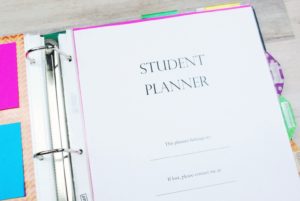[ad_1]
Use Planner Successfully:- You can get on top of your classes and have less stress in your life by learning how to utilize your planner to its full capacity.
Managing and daily use planner successfully can put you on the right track of completing assignments, managing tasks and preparing for all of your classes.

Make yourself a priority by setting monthly, weekly, and daily planning times. Set a weekly planning time to make sure big goals are broken down into short-term goals and even smaller wins. Then make sure important tasks are on your to-do list. Color coding can also help to keep tasks organized
It is no secret that by using a planner you will have better time management, motivation and ability to organize your calendar not only with class information but also workout plans, to-do lists, goals and much more.
Top tips to having a successful planner
- Schedule Deadlines
- Purchase a Planner that is Right for You
- Set Goals
- Carve out Time to Plan
- Keep Everything in One Planner
- Abide by the 2 Minute Rule
- Color Code your Tasks, Deadlines, Events, and More
Here are the best ways on how to use planner successfully:
1. Set Goals
Setting goals and placing them in your planner makes them more attainable.
Utilize the note section in your planner and come up with one academic and one personal goal, Olson says. Monitor your goals each week to make sure you are taking the necessary steps to complete them.
Reaching your goals becomes easier once you get in the habit of creating them. Remember if you set a goal, it should be a SMART (Specific, Measurable, Attainable, Realistic, Timely) one. Here are some examples of SMART goals you may want to implement into your planner.
- Work out at the gym three times a week for 30 minutes.
- Spend one hour each night working on assignments for classes.
- Save more money by putting 25 percent of your paycheck into a savings account for the next year
2. Schedule Deadlines
- Setting deadlines for all of your classes ensures you have a reminder set in place to finish assignments on time.
- “What I recommend doing is when you get all your syllabi at the beginning of the semester, take each syllabus and write every due date and exam into your planner,” professional academic advisor Megan Olson says. “It may take you an hour or two to do it, but you will have everything written down for the semester, so if you look at it every single day, you will know exactly what you need to do.”
- If you tend to procrastinate, you will be reminded to finish your assignments. However, you can also set soft deadlines for yourself. Soft deadlines ensure your assignments are done on time and ahead of schedule; therefore, if the assignment is complex or takes a little longer than you thought, you have the ability to come back to it before your hard deadline.
3. Color Code your Tasks, Deadlines, Events, and More
Color coding is one of the best ways to organize your tasks, deadlines, and events. You can use a different color per class, per category (like in step 4), or per family member. Once you choose your colors, be sure to create a color key and stick to these colors throughout your planning system!
Tip: If you run out of colors, or are trying to create subcategories, use a pen as the main color, and use highlighters as your sub-categories! For example, my school category color is blue, while each of my classes has their own specific color. So, in my planner, if I have a deadline for, let’s say differential equations (purple), I would write “take home test due” in blue, and highlight it in purple.
4. Purchase a Planner that is Right for You
- There are thousands of planners that you can purchase. Some are more goal-based, while others have a more simplistic view. Find a planner that best aligns with your organizational behaviors to receive the full benefits of the planner.
- If a paper planner doesn’t fit your personality, consider utilizing a virtual/digital planner. There are many digital planning applications that you can download onto your phone or computer that you can utilize.
- Once you find a planner that fits your needs, you are on the right track to staying organized for your classes.
5. Carve out Time to Plan
Each day, add “plan tomorrow” to your task list. During this time, be sure to add any tasks that have come up during the day to your task lists and review what needs to be done tomorrow. Use Planner Successfully
Creating a small list of everything you should be doing in your planner each day is an easy way to make your daily planning quick and painless. An example of a daily planning list might include: check off all completed tasks, migrate any unfinished tasks to another day, check tomorrow’s schedule, create a realistic task list and schedule for tomorrow, and check in with any current trackers (workouts, meal diary, check register, memory calendar, etc.).
6. Keep Everything in One Planner
In addition to writing everything down, make sure that everything you are tracking or planning is all in one planner. Be creative! There are hundreds of things you can have in your planner that can make your life so much easier!
Things to put in your planner:
- Calendars
- Yearly/long term calendars
- Monthly calendars
- Weekly calendars
- Daily calendar pages
- To-Do Lists
- House to-do list
- Work to-do list
- School to-do list
- Family to-do list
- Daily/Weekly/Monthly/Yearly to-do lists (see planning tip 16)
7. Abide by the 2 Minute Rule
Here is another Getting Things Done tip: if you can complete a task in less than 2 minutes, just DO IT NOW. You could have completed that task in the same amount of time it would have taken you to write it down and think about it later.
[ad_2]
Source link



